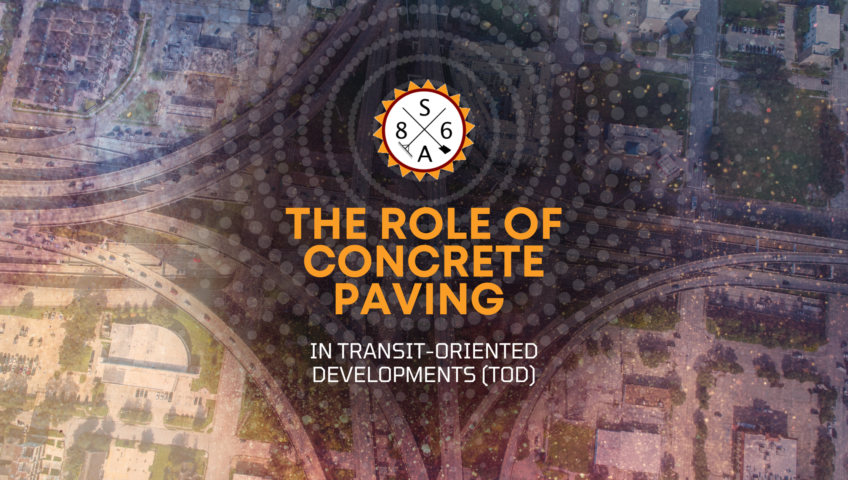
The Role of Concrete Paving in Transit-Oriented Developments (TOD)
As urban populations grow, cities face increasing pressure to create efficient, accessible, and sustainable spaces that meet the needs of residents, businesses, and commuters. Transit-Oriented Developments (TOD) are emerging as a solution, blending residential, commercial, and recreational areas around transit hubs. Concrete paving plays a crucial role in shaping these developments, offering durability, functionality, and sustainability. For commercial concrete and asphalt companies, the demand for infrastructure supporting TOD projects is a key growth area.
What Are Transit-Oriented Developments (TOD)?
Transit-Oriented Developments are mixed-use communities designed to maximize access to public transportation. Typically located near bus, subway, or train stations, TODs promote walkability, reduce traffic congestion, and minimize reliance on personal vehicles. The concept prioritizes high-density housing, retail, and office spaces, all within walking distance of major transit hubs. As TODs expand, there is an increasing need for infrastructure solutions that can withstand heavy foot traffic, regular transit vehicle use, and harsh weather conditions.
Concrete paving has emerged as the ideal solution for the critical infrastructure in TOD projects due to its strength, longevity, and ability to adapt to sustainable and innovative designs.
Why Concrete Paving?
- Durability and Longevity
Concrete is renowned for its durability, especially in commercial applications like TODs. It withstands high foot traffic, public transportation vehicles, and varying weather conditions, making it an excellent choice for transit-oriented spaces. Unlike asphalt, which may require more frequent maintenance, concrete’s lifespan is significantly longer, resulting in lower long-term costs.
For example, the commercial concrete used in parking lots, walkways, and transit routes within TODs remains durable even under heavy loads from buses and trains. In urban environments, where development is continuous and the budget is often tight, opting for concrete reduces maintenance disruptions and costs for businesses and city planners alike.
- Sustainability
Sustainability is a priority in modern urban planning, especially for transit-oriented developments aiming to reduce carbon emissions. Concrete, when sourced responsibly, is a sustainable option because it can incorporate recycled materials and offers excellent energy efficiency. It also improves the heat island effect by reflecting sunlight, rather than absorbing it like asphalt, helping to regulate the microclimate in densely populated areas.
Additionally, permeable concrete options are available, which help manage stormwater runoff by allowing water to filter through the pavement and return to the soil. This feature is particularly important in TODs, where green infrastructure is often a key component of the design.
- Enhanced Walkability and Safety
One of the goals of TODs is to create walkable environments that encourage pedestrian movement and public transit usage. Concrete paving is ideal for these applications because it offers a smooth, even surface that improves walkability and safety. Sloped walkways, curbs, and ramps can be easily integrated into concrete pavements, making the entire area accessible to all, including those with mobility challenges.
Moreover, commercial concrete near me options provide customizable features, such as slip-resistant finishes or colored and textured pavements, which can enhance the visual appeal and functionality of sidewalks, crosswalks, and plazas within TODs.
- Adaptability for Mixed-Use Spaces
Transit-oriented developments typically feature a blend of residential, commercial, and recreational spaces. Concrete paving is highly adaptable to this mixed-use environment. Whether it’s being used for public plazas, parking areas, or even outdoor dining spaces, concrete can be designed to meet various aesthetic and functional requirements.
For instance, stamped or decorative concrete can create vibrant public spaces that align with the community’s architectural theme while remaining functional and durable. Additionally, commercial asphalt companies are often turning to concrete for more decorative and long-lasting projects within these developments.
Concrete vs. Asphalt: The Better Option for TODs
While asphalt has been a go-to option for many urban areas, concrete is rapidly becoming the material of choice in transit-oriented developments for several reasons:
- Maintenance: Asphalt requires more frequent repairs and resurfacing, especially in high-traffic areas, increasing long-term maintenance costs. Concrete, on the other hand, is low-maintenance and can last for decades without significant repairs.
- Load-Bearing Capacity: Asphalt can deteriorate faster under the constant weight of buses, trucks, and trains. In contrast, concrete’s high load-bearing capacity makes it more resilient in TODs where public transportation vehicles frequently pass through.
- Environmental Impact: Asphalt is a petroleum-based product, contributing more to the carbon footprint than concrete. Sustainable concrete options, such as recycled and permeable concrete, align with the eco-friendly goals of TODs.
For city planners and commercial asphalt companies looking to balance cost, durability, and environmental impact, concrete is often the more practical solution for transit-oriented projects.
Impact on Commercial and Local Communities
The role of concrete paving in transit-oriented developments extends beyond its functional benefits—it significantly impacts the local community. Well-paved, attractive, and accessible areas around transit hubs make it easier for residents to commute, shop, and socialize. This, in turn, attracts businesses and boosts the local economy.
Moreover, local commercial concrete providers play an essential role in these projects by offering tailored solutions that meet the specific needs of the development and community. Whether it’s through sustainable concrete options, innovative design solutions, or simple cost-effective paving, the industry’s involvement in TODs shapes urban growth.
Cornerstone for Urban Development
Transit-Oriented Developments represent the future of urban living, and concrete paving is an integral part of their success. Its durability, sustainability, and versatility make it the perfect material for building resilient and attractive spaces that support public transit and pedestrian activity. As TODs continue to expand across cities, the demand for reliable commercial concrete near me services will grow, offering opportunities for businesses and improving urban environments for all.
Whether it’s creating sustainable, eco-friendly transit hubs or ensuring safe, walkable spaces, concrete paving is poised to be a cornerstone of urban development for years to come.
